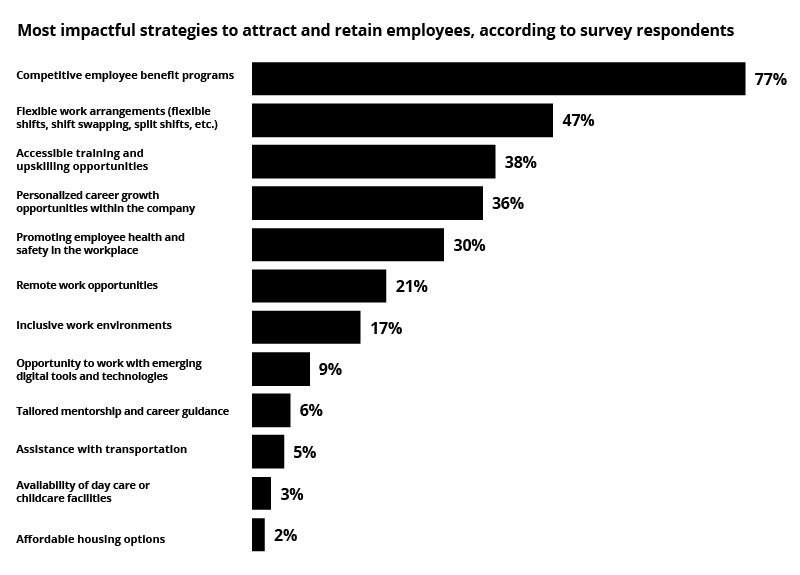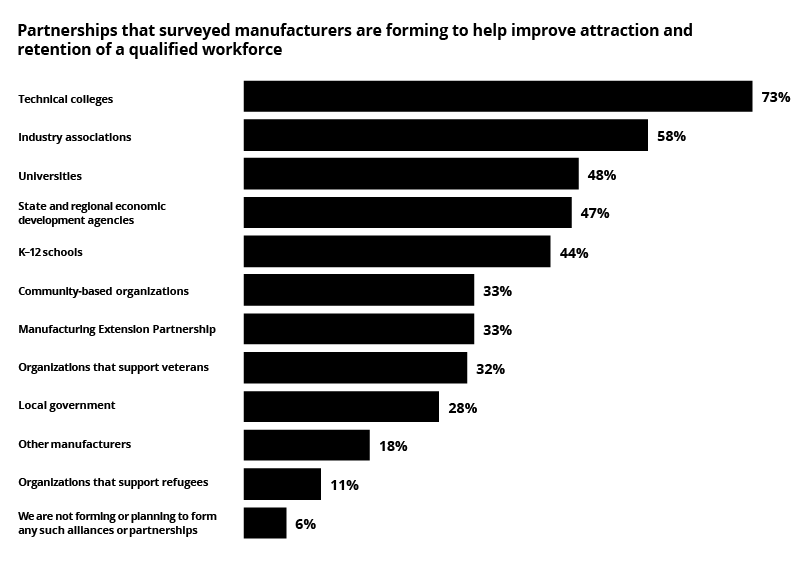Manufacturing Talent Strategy Development | Deloitte US has been saved
Authored by Victor Reyes, Leticia Roinesdal, and John Coykendall
The state of US manufacturing: Workforce challenges amid growth
The US manufacturing industry is experiencing strong growth. Employment has surpassed pre-COVID-19 pandemic levels, 1and investments to build new or expand existing manufacturing facilities have more than tripled since June 2020. 2This growth is driving the need for more workers of every type—from entry-level associates to skilled production workers to engineers. However, workforce issues remain a leading concern for manufacturers. Evolving skill requirements and a shortage of applicants for open positions in manufacturing indicate that there is not just a skills gap, but a notable applicant gap as well. Our recent study, Taking charge: Manufacturers support growth with active workforce strategies, conducted this year in collaboration with The Manufacturing Institute, highlights that there is a shift underway in the sector and, in general, companies are currently developing a more active approach to address both the talent skills gap and the applicant gap. The study found several approaches described herein that, when used in combination, can help manufacturers overcome the talent challenges they face.
Adapting to changing workforce expectations to help improve hiring and retention
Higher numbers of millennial and Generation Z workers are joining the workforce, and they can have a different set of expectations when it comes to work culture and the work environment itself.3To help meet these expectations, surveyed manufacturing executives from our study indicated that they are offering work arrangements that support flexibility—such as working from home, shift swapping, split shifts, part-time positions, and childcare support. Some manufacturers are strategically working with state or local governments to investigate and develop affordable workforce housing options for talent. They are also taking a bigger role in skills development and creating training programs to strategically foster an agile and versatile workforce using internal training academies, e-learning platforms, skills assessments, mentoring, knowledge transfers, and rotational programs for new talent.

Applying a customer focus can create a leading employee experience
Some manufacturers are applying a customer focus to their workforce to understand what the employee needs and creating engaging, innovative workforce solutions. Our report highlights that manufacturers can enhance the workforce experience by creating a sense of purpose for their employees, a safe and comfortable work environment, and implementing technology that can help engage and empower workers. When employees are happy with the company’s values, impact, and culture, it can provide motivation and help drive performance. Developing a comfortable working environment, such as by adding natural light, was identified to be strategically important for both attracting new talent and retention. Technology can also help attract workers, augment their physical and mental capabilities, and support flexible and efficient upskilling.
Taking an ecosystem approach to attract and upskill talent
The 2024 Deloitte and The Manufacturing Institute Talent Study corroborates that many manufacturers are establishing ecosystems to help strategically expand their talent pool and develop the requisite skills. Manufacturers are forming partnerships to build awareness of manufacturing careers and opportunities, leverage and support training programs, and engage groups that may experience unique barriers to employment—such as veterans, refugees, and individuals who were formerly incarcerated—which can create a more diverse and inclusive workforce.

Building an innovative talent development strategy
It can take a dedicated effort, and perhaps additional resources, to adopt an ecosystem approach and focus on the many aspects of worker experience. Companies will likely need to build relationships within the community, benchmark innovative programs, and develop new strategies to support the needs of various talent applicant groups. New roles on the talent development team and close partnerships with production leaders may be necessary to provide the requisite expertise, training, and support when implementing innovative talent programs.
Final thoughts
Manufacturers will likely continue developing and adopting proactive, strategic, and innovative approaches to address talent challenges. An ecosystem approach can help manufacturers attract and recruit more workers to the industry—providing them with the skills they need. However, with the manufacturing industry poised for growth over the next decade, the challenge is not only recruiting and upskilling the people needed to fill the potential new jobs but also retaining them. An engaging, elevated employee experience can shape their professional journey and foster an inclusive and collaborative workplace, which can help manufacturers improve retention.
Learn more about Deloitte’s Industrial Products & Construction practice and Human Capital practice.
Authors:
John Coykendall
Vice Chair
US Industrial Products & Construction Leader
Deloitte Consulting LLP
jcoykendall@deloitte.com
Victor Reyes
Managing Director
Deloitte Consulting LLP
vreyes@deloitte.com
Leticia Roinesdal
Principal
Deloitte Consulting LLP
lroinesdal@deloitte.com
Endnotes:
1 US Bureau of Labor Statistics, “The employment situation—May 2024,” released June 7, 2024.
2 United States Census Bureau, Construction Spending - Data, last revised July 1, 2024.
3 Paul Wellener et al., Competing for talent: Recasting perceptions of manufacturing, Deloitte and The Manufacturing Institute, March 30, 2022.

